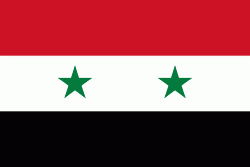Darkush (Darkūsh)
Darkush (دَرْكُوش; also spelled Darkoush or Derkush) is a town in northern Syria, administratively part of the Idlib Governorate, located northwest of Idlib along the Syrian–Turkish borders on the Orontes River. Nearby localities include al-Janudiyah, Zarzur and al-Najiyah to the southwest, Jisr al-Shughur to the south and Millis and Maarrat Misrin to the east. According to the Syria Central Bureau of Statistics, Darkush had a population of 5,295 in the 2004 census. The town is also the administrative center of the Darkush nahiyah which consists of 19 villages with a combined population of 23,022. Its inhabitants are predominantly Sunni Muslims.
An inscription at the town, dating back to Roman times, attests to the existence of a shipwright in the town, building river-going boats to use on the Orontes. The town also has the remains of an ancient bridge. The Christianization of the city probably happened after 322.
During the Crusades, the town was the property of the Principality of Antioch until it was captured by Saladin in 1188. The town fell back to the Crusaders under Bohemond VI of Antioch and Tripoli in 1260. The city was finally re-captured by the Mamluk Sultan Baibars in 1267. Nothing remains of the town's Crusader citadel, as it was quarried for building stones. Darkush was visited by Syrian geographer Yaqut al-Hamawi in the 1220s, during Ayyubid rule. He noted that it was a "fortress near Antâkiyyah, in the 'Awâsim Province."
On 13 August 1822 the town and its surrounding areas were devastated by a massive earthquake. The earthquake is said to have killed 20,000 people all together.
An inscription at the town, dating back to Roman times, attests to the existence of a shipwright in the town, building river-going boats to use on the Orontes. The town also has the remains of an ancient bridge. The Christianization of the city probably happened after 322.
During the Crusades, the town was the property of the Principality of Antioch until it was captured by Saladin in 1188. The town fell back to the Crusaders under Bohemond VI of Antioch and Tripoli in 1260. The city was finally re-captured by the Mamluk Sultan Baibars in 1267. Nothing remains of the town's Crusader citadel, as it was quarried for building stones. Darkush was visited by Syrian geographer Yaqut al-Hamawi in the 1220s, during Ayyubid rule. He noted that it was a "fortress near Antâkiyyah, in the 'Awâsim Province."
On 13 August 1822 the town and its surrounding areas were devastated by a massive earthquake. The earthquake is said to have killed 20,000 people all together.
Map - Darkush (Darkūsh)
Map
Country - Syria
 |
 |
| Flag of Syria | |
The name "Syria" historically referred to a wider region, broadly synonymous with the Levant, and known in Arabic as al-Sham. The modern state encompasses the sites of several ancient kingdoms and empires, including the Eblan civilization of the 3rd millennium BC. Aleppo and the capital city Damascus are among the oldest continuously inhabited cities in the world. In the Islamic era, Damascus was the seat of the Umayyad Caliphate and a provincial capital of the Mamluk Sultanate in Egypt. The modern Syrian state was established in the mid-20th century after centuries of Ottoman rule. After a period as a French mandate (1923–1946), the newly-created state represented the largest Arab state to emerge from the formerly Ottoman-ruled Syrian provinces. It gained de jure independence as a democratic parliamentary republic on 24 October 1945 when the Republic of Syria became a founding member of the United Nations, an act which legally ended the former French mandate (although French troops did not leave the country until April 1946).
Currency / Language
| ISO | Currency | Symbol | Significant figures |
|---|---|---|---|
| SYP | Syrian pound | £ or لس | 2 |
| ISO | Language |
|---|---|
| AR | Arabic language |
| HY | Armenian language |
| EN | English language |
| FR | French language |
| KU | Kurdish language |















